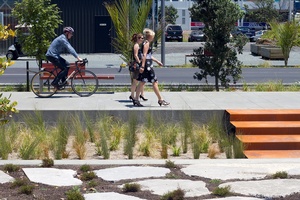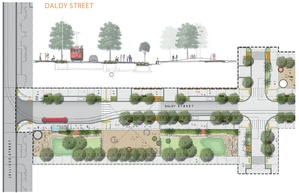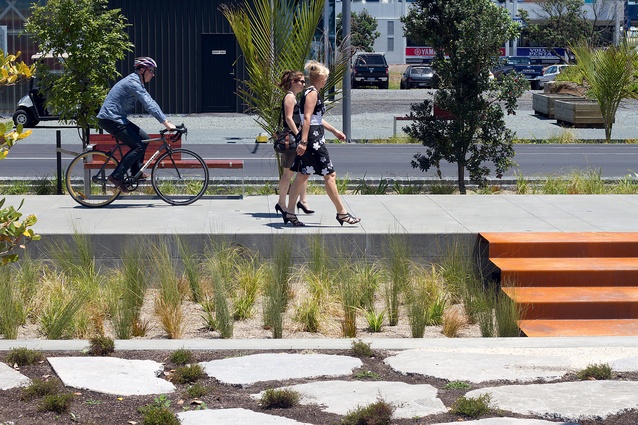Daldy Street Park – Auckland
Looking south towards Victoria Park from Daldy Street it is hard to believe this piece of reclaimed land was, and often still is, colloquially referred to as ‘the tank farm’.
Following an extensive redevelopment programme undertaken by Waterfront Auckland as part of the overall revitalisation of a significant area of land on Auckland’s Waterfront, the central section of Daldy Street now sits comfortably on the fence; somewhere between a park
and a street.

The road opens up a new north-south line through the area; a green swathe between Victoria Park to the south and the future Headland Park to the north, which will sit on the shores of the Waitemata Harbour.
Its landscaping is reflective of a complex layering of history and association; from its original nature as part of the wider Freemans Bay catchment, originating from the area around Western Park and Karangahape Road, to its subsequent use by the petro-chemical industry (the tank farm), along with its placement on the waterfront and maritime heritage.
Landscape architect Henry Crothers (now of Landlab, but formerly of Architectus) says the question arose early in the piece about whether it was a street or a park.
“We came to the realisation that it is both. It’s a hybrid project in a way. And in time the planting will further blur the boundaries between street and park.”

This fusion of park and street is accentuated by the four-metre wide footpaths, undulating grassed areas, timber boardwalk-style bridges and rain gardens that make up the park element. The kerbless street operates as a shared space, predominantly geared towards use by cyclists, buses and trams; private vehicles are of lowest priority here.
The adjacent Beaumont and Halsey streets are designed as the main vehicular entry points to the area, allowing Daldy Street to adopt a more pedestrian-focused ‘shared surface’ design strategy.
The project is interesting in that it is one of the first stages in the overall development of the area to be completed and has laid the foundations for the nature of future development.
The young planting is yet to mature, but it is clear the native species will develop to create an overtly New Zealand environment. On either side of the street construction is just getting underway; around $850 million of private residential and commercial buildings will soon rise around this green swathe.
“Daldy Street provides the spine through the precinct,” Crothers says. “It accommodates the enabling infrastructure that will support the surrounding development – storm water above and below ground, power, communications and public transport. It is the main trunk line for all these services for the entire precinct.
“The design language references both the presence and the absence of the former tanks. The round forms we have incorporated reference that history. The use of Corten steel provides another nod to the former industrial use of the site.
“It has a very elemental palette; concrete, steel and timber are the predominant materials.”

While referencing industry, the design also focused on sustainability. Crothers says the aim was to use low embodied energy products. So the lighting is all low-energy LED, and the concrete was sourced locally.
Recycled basalt kerb stones were recovered from Auckland Council yards and incorporated as a feature, set amongst a special mix of Aggrok, developed specifically for this site to incorporate a larger shell component in reference to its geographical location. Former hardstand areas have been retained within the project and existing concrete slabs associated with its industrial use have been re-used as paving.
“The design approach sought to dissolve the distinction between road and street through the use of rain gardens and planting. There is layering of circulation and spaces – and a contrast between the direct road and the more meandering route through the park area that provides engagement with the planting and rain gardens,” Crothers says.
Originally the site was ear marked to continue the exotic planting of Victoria Park, but the decision was made early on to use natives instead and focus on creating a uniquely coastal environment. Local iwi Ngāti Whātua had a significant input into the selection of species and were able to supply the majority of the foliage plants from their nursery.
Nine species of plants were used on the site (Sand comprosma, purei, rautahi, Maori sedge, pukio, Dianella, mikoikoi, New Zealand flax and pohuehue), while 85 native trees are dotted around the site including pohutukawa, kowhai, puriri and karaka.
The rain gardens, which flank the footpath, collect storm water and deliver it into a below ground storm water system.
Waterfront Auckland’s Luke Henshall says the landscaping provides an “authentic, gritty waterfront feel”.
“The use of former piping from the silos and the rusted seating honours the heritage of the area,” Henshall says.
“As a publically funded development agency, our mandate was to roll out a beautifully designed public realm, which would be the precursor to the private investment around it.”
Construction of stage two of the Daldy Street revitalisation began in February, which will see the extension of Crother’s design implemented on the northern end of the street. It is expected to be completed later this year.


















